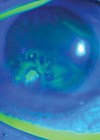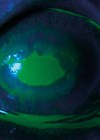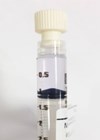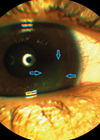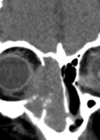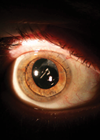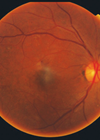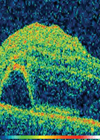Photoessay
Is this a retinal detachment?
Despite the help of allied health professionals in triaging and managing acute ophthalmic emergencies, eye casualty remains overburdened. Trainees at the beginning of their training often struggle to manage such busy clinics with varied presentations. We present a case that...
Applanation tonometry in the pandemic era: Are facial masks an obstacle to a correct intraocular pressure measurement?
Current recommendations in the UK advise on wearing any facial covering to prevent the spread of the coronavirus [1]. Whilst this is vital for patient and hospital staff safety, it has led to several changes in the approach to a...
Recurrent corneal erosions secondary to isotretinoin use
Isotretinoin (13–cis-retinoic acid) is the first line treatment for moderate to severe nodulocystic or papulopustular acne [1,2]. Although it is a safe medication, it has several adverse side-effects, including ophthalmic manifestations, as shown in Table 1 [3]. These side-effects need...
Anaesthetic drops abuse
A 67-year-old retired female nurse presented with persistent, bilateral, non-healing (>6 weeks) corneal ulcers and stromal ring infiltrates (Figures 1 and 2). The epithelial defects were the result of chemical burns caused by her contact lenses which had been stored...
Trabeculectomy with erroneous Mitomycin-C concentration – a near miss
Trabeculectomy is the most commonly performed surgical procedure for glaucoma in the United Kingdom and worldwide. Modifications to the technique have been made since its introduction in 1963, perhaps the most significant being the adjunctive use of mitomycin-C (MMC), which...
A step-by-step approach to the diagnosis and management of Sands of Sahara Syndrome
Sands of Sahara syndrome (diffuse lamellar keratitis) is a rare postoperative complication of Laser in situ keratomileusis (LASIK). Its estimated prevalence is reported to be 2-4% among LASIK cases [1], despite that, it is more likely to be encountered by...
Chronic dacryocystitis?
Lacrimal drainage system tumours are rare and lymphomas account for less than 10% of these tumours [1]. Most patients presenting with lymphoma infiltration of the lacrimal drainage system have a history of previously diagnosed lymphoma elsewhere. We report a case...
An unusual case of silicone oil in the anterior chamber simulating intraocular implant
Silicone oil internal tamponade has been used for over 50 years, even prior to pars plana vitrectomy [1].Over a course of time silicone oil may migrate to the anterior chamber through the pupil. This may disperse in the form of...
Fundus photography in Malawi – setting up a screening programmefor diabetic retinopathy
We present the case of a 53-year-old lady who presented to the diabetes outpatient clinic at Kamuzu Central Hospital (KCH), Lilongwe, Malawi. She was diagnosed with type 2 diabetes mellitus six years ago, for which she takes metformin orally. She...
Systemic sarcoidosis presenting with acute myopia and angle closure
Case report A 40-year-old Asian man presented to the Emergency Department with a one day history of sudden onset visual disturbance in his right eye. He complained of image distortion and noted that objects now appeared smaller. He also described...
Cyanoacrylate nail glue accidentally instilled into the eye instead of eye drops
Three hundred thousand cataract operations take place each year in the UK alone and each patient will receive a four week course of drops in order to cover them for any postoperative inflammation or infection. Accidental instillation of cyanoacrylate glue...
Bovine pericardium scleral patch graft associated scleritis: Ahmed valve implant for pupillary block glaucoma
Processed bovine pericardium is a lyophilised collagen sheet used as a surgical armamentarium. It renders the material antigenically inert with minimal inflammation [1]. Sclera patch pericardium graft (Tutopatch) is a collagenous membrane derived from solvent preserved, irradiated bovine pericardium [2]...




